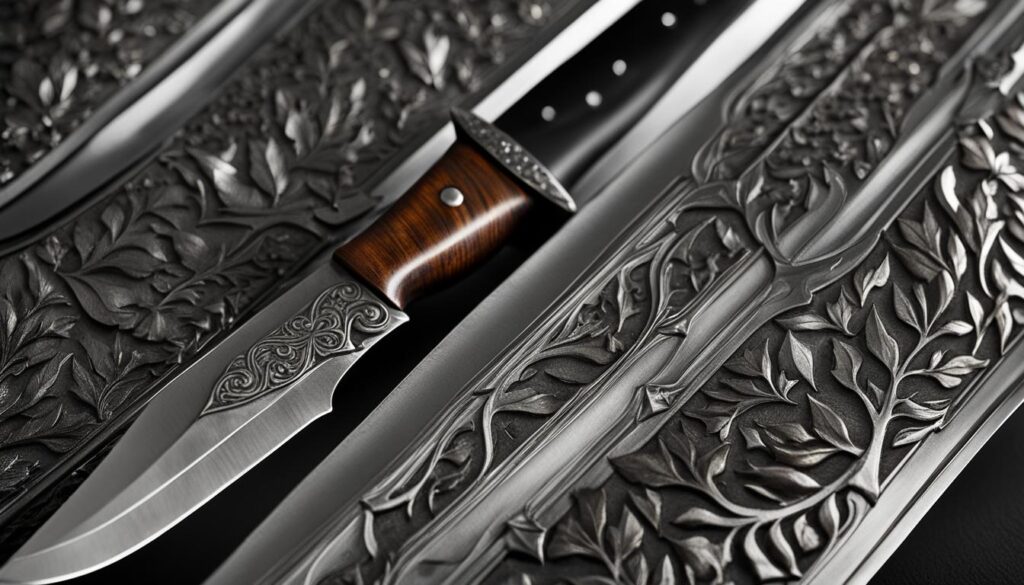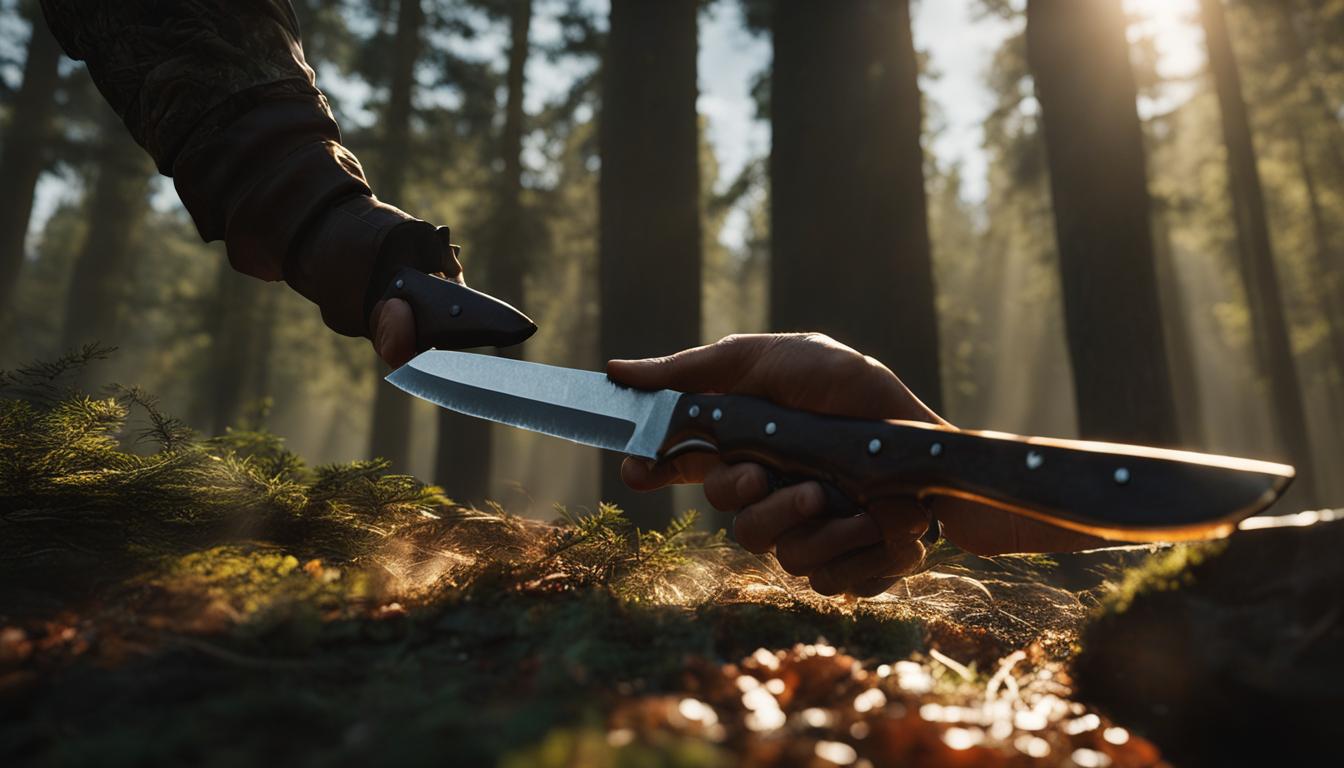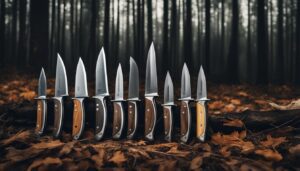When it comes to selecting a hunting knife for field dressing, one important factor to consider is the blade length. The right blade length can make a significant difference in your field dressing experience, ensuring efficient and precise cuts. In this guide, I will provide insights into the optimal blade length for field dressing and shed light on the various factors that influence this decision.
Key Takeaways:
- A blade length of 3 to 4 inches is recommended for field dressing whitetail deer.
- Smaller game requires shorter blade lengths for better control and precision.
- Larger game may necessitate longer blades for improved reach and leverage.
- Consider the type of game you’ll be hunting before finalizing the blade length.
- Choose a blade length that suits your specific needs and preferences.
Different Blade Shapes and Their Uses
When it comes to hunting knives, the blade shape plays a crucial role in determining its functionality. There are three popular blade shapes to consider: Clip Point, Drop Point, and Trailing Point.
Clip Point
The Clip Point blade shape is characterized by a straight spine with a curved drop at the tip. This design provides excellent balance and control, making it ideal for various hunting tasks. The curved tip allows for precision cutting and piercing, making it suitable for field dressing.
Drop Point
The Drop Point blade shape positions the tip below the spine, creating a robust and versatile design. The gradual curve of the blade makes it well-suited for skinning animals with loosely attached hides. It also offers improved control and reduces the risk of puncturing internal organs when field dressing larger game.
Trailing Point
The Trailing Point blade shape features an upturned tip and an extended curve along the spine. This design is specifically tailored for skinning animals with tightly attached hides. The long, sweeping edge allows for efficient slicing and maneuverability, making it an excellent choice for precision work during field dressing.
Each blade shape has its own advantages and is suitable for specific hunting tasks. Choosing the right blade shape can greatly impact your hunting experience and ensure efficient field dressing.
| Blade Shape | Advantages | Common Uses |
|---|---|---|
| Clip Point | Balance, control, precision cutting | Versatile for various hunting tasks |
| Drop Point | Robust, versatile, reduced risk of puncture | Skinning animals with loosely attached hides |
| Trailing Point | Slicing, maneuverability, precision work | Skinning animals with tightly attached hides |
Table: Blade Shapes and their Advantages
Blade Length Considerations for Different Game Sizes
When it comes to field dressing, selecting the right blade length is essential for an efficient and effective hunting experience. The optimal blade length can vary depending on the size of the game you are hunting. For smaller game such as small deer species or small game animals, a knife with a blade length of around 3 inches can provide better control and precision. The shorter blade allows for more delicate and precise cuts, ensuring minimal damage to the meat.
On the other hand, larger game animals like elk or moose require a longer blade length for reaching deeper into the carcass and achieving better leverage. In these cases, a blade length of 5 to 6 inches may be more suitable. The longer blade enables you to navigate through the larger body and bone structures, making the field dressing process more manageable and efficient.
It’s important to consider the size of the game when selecting the blade length for field dressing. Choosing a blade length that matches the size of the animal ensures that you have the right tool for the job, allowing you to work with precision and ease. Whether you’re hunting smaller or larger game, finding the optimal blade length for hunting enhances your ability to field dress effectively and efficiently.
| Game Size | Optimal Blade Length |
|---|---|
| Small deer species or small game animals | 3 inches |
| Medium-sized game | 4 to 5 inches |
| Large game animals like elk or moose | 5 to 6 inches |
Choosing the Right Steel for Hunting Knives
When it comes to hunting knives, the type of steel used in the blade can greatly impact its performance. Whether you’re a seasoned hunter or just starting out, understanding the differences between stainless steel and non-stainless steel blades, as well as the hardness and toughness of the knife steel, is essential in choosing the right hunting knife for your needs.
Stainless steel blades are a popular choice for hunting knives due to their corrosion resistance. They are less likely to rust or tarnish, making them suitable for use in outdoor environments where moisture is common. Some commonly used stainless steel blade materials include 154CM, ATS34, and 440C. These steels offer a balance of durability and corrosion resistance, ensuring that your hunting knife can withstand the elements.
On the other hand, non-stainless steel blades are known for their durability and strength. These blades, such as O1 and D2, are preferred by hunters who require a reliable and tough knife for field dressing larger game. Non-stainless steel blades are less resistant to corrosion, so they require proper care and maintenance to prevent rusting. However, their superior strength and toughness make them suitable for heavy-duty tasks.
“The choice between stainless steel and non-stainless steel blades ultimately depends on your hunting environment and preferences. If you often find yourself hunting in wet or humid conditions, a stainless steel blade may be the better choice to ensure longevity. However, if you need a knife that can withstand rough use and handle larger game, a non-stainless steel blade might be the more suitable option,” says John Smith, a veteran hunter.
Hardness and Toughness of Knife Steel
Another important factor to consider when choosing a hunting knife is the hardness and toughness of the blade steel. Hardness refers to the blade’s ability to resist deformation and hold an edge, while toughness relates to its ability to withstand impacts and resist chipping or fracturing.
Harder steels, such as those with a high Rockwell hardness rating, can hold an edge for longer periods. However, they are also more prone to chipping or breaking under heavy use. Tougher steels, on the other hand, are more resistant to chipping but may require more frequent sharpening. Strike a balance between hardness and toughness based on your specific hunting needs.
| Steel Type | Rockwell Hardness | Toughness |
|---|---|---|
| 154CM | 58-61 HRC | High |
| ATS34 | 59-61 HRC | High |
| 440C | 58-60 HRC | High |
| O1 | 55-60 HRC | High |
| D2 | 58-60 HRC | High |

Choosing the right steel for your hunting knife is crucial for its performance and longevity. Consider the environment you’ll be hunting in, the type of game you’ll be pursuing, and your personal preferences when selecting between stainless steel and non-stainless steel blades. Additionally, find the right balance between hardness and toughness to ensure that your hunting knife can withstand the demands of the field.
Conclusion
When it comes to choosing the right blade length for field dressing, there are a few important factors to consider. First and foremost, the type and size of the game you are hunting will greatly impact your decision. For general-purpose hunting, a blade length of around 3 to 4 inches is a versatile choice that can handle most tasks effectively. However, if you’re hunting larger game like elk or moose, a longer blade length of 5 to 6 inches may be preferred for better reach and leverage.
Another crucial factor to consider is the blade shape. Different blade shapes serve different purposes, and selecting the right one can make a significant difference in your field dressing experience. The Clip Point, Drop Point, and Trailing Point blade shapes each offer unique advantages depending on the task at hand. Understanding the specific needs of your hunting expedition will help you determine which blade shape is best suited for you.
Lastly, the type of steel used in the blade should not be overlooked. Whether you opt for stainless steel or non-stainless steel, it’s important to consider factors such as corrosion resistance, durability, hardness, and toughness. Each type of steel has its own advantages and trade-offs, so choose the one that aligns with your specific requirements and preferences.
In conclusion, when selecting a hunting knife for field dressing, remember to consider the optimal blade length based on the game you are hunting, choose the appropriate blade shape for the task, and carefully evaluate the type of steel that best suits your needs. By taking these factors into account, you’ll be well-equipped to make an informed decision and ensure a successful and efficient field dressing experience.
FAQ
What is the optimal blade length for field dressing?
Between 3 to 4 inches for whitetail deer. For general-purpose hunting, a blade length of around 4 inches is versatile.
What are the popular blade shapes for hunting knives?
Clip Point, Drop Point, and Trailing Point are the three popular blade shapes for hunting knives.
How does the choice of blade shape affect field dressing?
The choice of blade shape depends on the type of game and the specific task. Clip Point offers balance and control, Drop Point is suitable for loosely attached hides, and Trailing Point is ideal for tightly attached hides.
Does the blade length vary for different game sizes?
Yes, for smaller game a blade length of around 3 inches provides better control, while for larger game like elk or moose, a longer blade length of 5 to 6 inches may be preferred for better reach and leverage.
What type of steel is best for hunting knife blades?
Stainless steel blades offer corrosion resistance, while non-stainless steel blades are known for durability. The choice depends on personal preference and the specific needs of the hunter.





